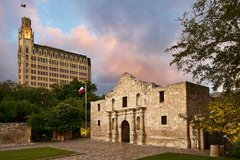Dr. R. Bruce Winders, Former Alamo Director of History and Curator
The Alamo’s days as a military outpost were drawing to a close. The end of the Civil War occasioned the return of the United States Army to San Antonio, including its reoccupation of the old church and Long Barrack. Soldiers also returned to the line of western forts abandoned at the start of the war. Although settlers still faced raids from hostile Indians, Texas was transforming from a raw frontier to a landscape dotted with established cities, towns, farms, and ranches. Even San Antonio, which had existed for nearly one hundred and fifty years on the leading edge of the Spanish/Mexican/Texan/U.S. frontier, began to reflect this change.
Several factors revived San Antonio’s fortunes. The return of the U.S. Army brought stability to the region as well and resurrected a local market for corn, hay, and cattle. Moreover, in the few first years after the war, San Antonio became a cattle town as south Texas ranchers moved herds north along the Chisolm Trail to Kansas. The town’s merchants outfitted trail bosses and drovers with necessary supplies for their drives, which could last between three and four months. During this era the city council passed ordinances designed to regulate rowdy cowboy behavior such as “immoderately riding or driving” animals through the streets and plazas. Notices also went out to warn freighters and cattlemen that they could no longer park wagons in the city plazas overnight. The arrival of the railroad to San Antonio in 1877 also impacted the city, as it transformed San Antonio into a rail head, meaning that cattle could be shipped out and goods shipped in. The train also began to bring an increasing number of travelers attracted to San Antonio by its exotic location and historic past.
San Antonio’s newfound prosperity affected the Alamo. The location of the old mission and fort made its grounds desirable real estate. Councilmen and merchants sought to transform the mission’s footprint from its industrial park-like existence into something more suitable for a growing, prosperous city. In 1871, the Catholic Archdiocese, which still owned the property, sold the central portion of the old compound — today known as Alamo Plaza — to the city. The city removed the old granary located at the southern end of the compound and put a city run meat market in its place.





